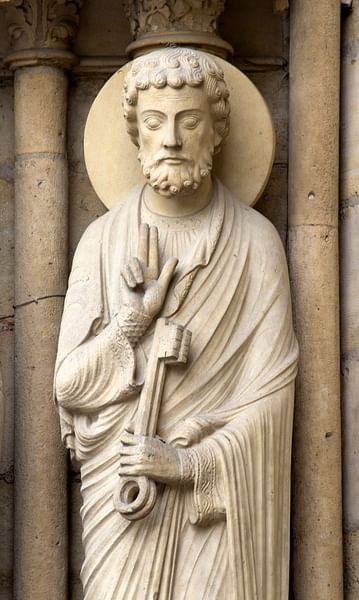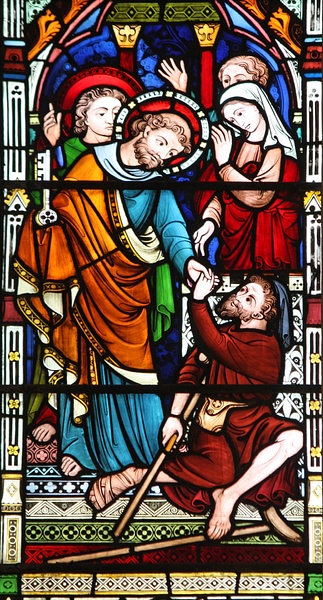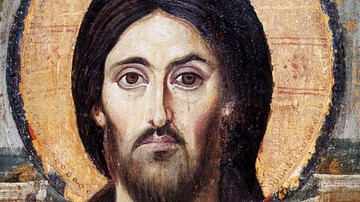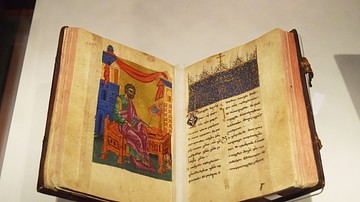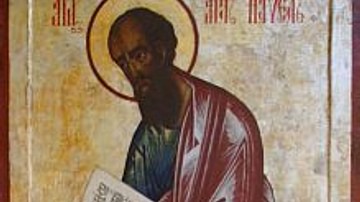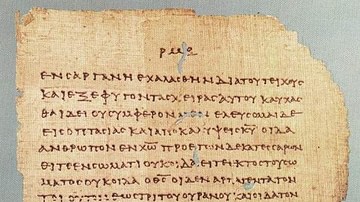
Saint Peter the Apostle was a well-known figure in early Christianity. Although there is no information on the life of Peter outside the Bible, in the Christian tradition, he is often depicted as the first on many occasions: the first to be called by Jesus, the first who recognized Jesus as 'the Christ', the first disciple to receive a post-resurrection appearance by Jesus; and retrospectively, the first pope of Rome. He is referred to as Simon Peter, Simeon, and Simon, son of Jonah. Paul often referred to him as Cephas, Aramaic for either 'crag' or 'stone', translated into the Latin 'Petrus', Peter. In biblical tradition, when someone was called by God (or in this case, Jesus), it was followed by a name change to indicate a new worldview.
Sources
Our sources for the life and ministry of Peter are many:
- the letters of Paul
- the gospels
- the Acts of the Apostles
- letters of several early bishops
- a Gospel of Peter
- two letters in the New Testament
- the Acts of Peter
- and later histories of Christianity in the 4th and 5th centuries CE.
Unfortunately, Peter did not write anything down. However, we can attest to the historicity of Peter from several of Paul’s letters (c. 50s-60s CE). Paul met with him twice in Jerusalem, in Antioch, and perhaps in Corinth. In 1 Corinthians 15, when reviewing what he taught, Paul said that Jesus "appeared to Cephas, and then to the Twelve." When the early missionaries encountered non-Jews (Gentiles) who wanted to join, both Luke (in the Acts of the Apostles) and Paul related a meeting in Jerusalem to decide what to do about these Gentiles. It was decided that they did not have to become Jews - no circumcision, no dietary laws, and no Sabbath observance - but all idolatry had to cease. They became the Gentile-Christians, as opposed to Jewish-Christians. There is an odd passage in Paul’s letter to the Galatians:
But when Cephas came to Antioch, I opposed him to his face, because he stood self-condemned; for until certain people came from James, he used to eat with the Gentiles. But after they came, he drew back and kept himself separate for fear of the circumcision faction. And the other Jews joined him in this hypocrisy . . . I said to Cephas before them all, "If you, though a Jew, live like a Gentile and not like a Jew, how can you compel the Gentiles to live like Jews?" (Galatians 2:11-14)
Largely because of this letter, Peter became associated with the “Jewish-Christian” point of view in Jerusalem.
Peter in the Gospels
In the gospels, the portraits of Peter vary from someone at times confused and frightened to an insightful person at other times. Such variation is best understood within the narrative function of each specific passage and the overall arguments of each gospel writer. The gospels also reflect traditions in their own communities which may have been passed down, perhaps from the original disciples.
Peter was one of the first disciples of Jesus. "As Jesus walked beside the Sea of Galilee, he saw Simon and his brother Andrew casting a net into the lake, for they were fishermen. 'Come, follow me,' Jesus said, 'and I will send you out to fish for people'" (Mark 1:16-20). This is also when the sons of Zebedee, James and John, joined the movement. In the list of the disciples as well as specific incidents, these three are highlighted together first, as "Peter, James, and John" (although the lists do not often agree after these three names).
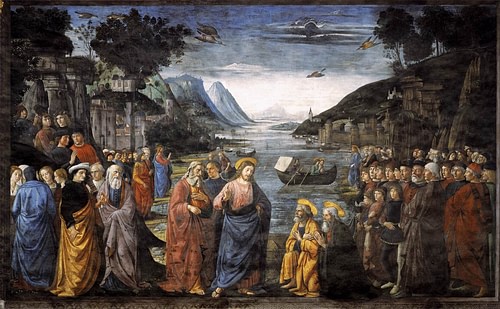
After Jesus drove out "an unclean spirit" from a man in the synagogue at Capernaum in Mark, the group then moved to Peter’s house: "Simon’s mother-in-law was in bed with a fever, and . . . Jesus took her by the hand and lifted her up. Then the fever left her, and she began to serve them" (Mark 1:29-31). The remains of a multi-layered synagogue are at Capernaum today. Next to it is the "house of Peter", which was an early pilgrimage site for Christians. The fourth gospel, John, however, claimed that Peter and his brother Andrew were from Bethsaida, a town on the northern end of the Sea of Galilee (John 1:44).
In between the mass feeding stories, Jesus was praying on a mountain while the disciples got into a boat to cross to the other shore. As a storm descended, Jesus came walking to them on the water. The disciples cried out in fear, "It’s a ghost!" Jesus said, "Take courage! It is I. Don’t be afraid." "Lord, if it’s you," Peter replied, "tell me to come to you on the water." Peter got out, but feeling himself beginning to sink, cried out, "Lord, save me!" Jesus reached out, but chastised him: "You of little faith ... why did you doubt?" (Matthew 14:25-31).
After six days Jesus took Peter, James and John with him and led them up a high mountain, where they were all alone. There he was transfigured before them. ... And there appeared before them Elijah and Moses, who were talking with Jesus. Peter said to Jesus, "Rabbi, it is good for us to be here. Let us put up three shelters—one for you, one for Moses and one for Elijah." He did not know what to say, they were so frightened. (Mark 9:2-8)
In this scene, Peter cannot move beyond a literal understanding. Booths, tents, or shrines were often erected in places where people had encountered divinity. However, in another scene, we encounter the insightful Peter:
Jesus and his disciples went on to the villages around Caesarea Philippi. On the way he asked them, "Who do people say I am?" They replied, "Some say John the Baptist; others say Elijah; and still others, one of the prophets." "But what about you?" he asked. "Who do you say I am?" Peter answered, "You are the Messiah." Jesus warned them not to tell anyone about him. (Mark: 8:27-30).
Matthew’s extension of Mark's passage created Peter’s ultimate standing among the disciples:
"But what about you?" he asked. "Who do you say I am?" Simon Peter answered, "You are the Messiah, the Son of the living God." Jesus replied, "Blessed are you, Simon son of Jonah, for this was not revealed to you by flesh and blood, but by my Father in heaven. And I tell you that you are Peter, and on this rock I will build my church, and the gates of Hades will not overcome it. I will give you the keys of the kingdom of heaven; whatever you bind on earth will be bound in heaven, and whatever you loose on earth will be loosed in heaven." Then he ordered his disciples not to tell anyone that he was the Messiah. (Matthew 16:15-20).
The power of this binding contains the power to forgive sin, exorcise demons, excommunicate someone, and the authority to teach.
The most famous story of Peter takes place during the last days of Jesus on earth. At the last supper, Jesus, in discussing betrayal, said:
"You will all fall away, ... for it is written: 'I will strike the shepherd, and the sheep will be scattered.'" ... Peter declared, "Even if all fall away, I will not." "Truly I tell you," Jesus answered, "today—yes, tonight—before the rooster crows twice you yourself will disown me three times." (Mark 14:27-30).
Jesus then went to pray at Gethsemane, and again, Peter, James, and John are mentioned. Jesus asked them to stay awake, but three times Jesus had to wake them:
"Simon," he said to Peter, "are you asleep? Couldn’t you keep watch for one hour? Watch and pray so that you will not fall into temptation. The spirit is willing, but the flesh is weak." (Mark 14:37-38).
When Judas came with the chief priests, the scribes, and the elders to arrest Jesus, we are told that someone grabbed a sword and cut off the ear of the slave of the high-priest, which Jesus then restored. It is only in John’s gospel that it was Peter who struck the slave.
Mark said that upon the arrest, "all of them deserted him and fled.” However, while Jesus was being tried, Peter was in the courtyard where a servant girl saw him: "You also were with that Nazarene, Jesus." (Mark 14:67) Peter denies it not once but three times: "He began to call down curses, and he swore to them, 'I don’t know this man you’re talking about.' Immediately the rooster crowed the second time. ... And he broke down and wept. (Mark 14: 71-72). Luke added a poignant line, "The Lord turned and looked straight at Peter," which then caused him to weep (Luke 22:61).
The Gospel of John
The fourth gospel contains many of the same elements of the ministry of Jesus, but Peter is somewhat diminished in this text. John’s gospel consistently highlights someone called "the beloved disciple" who is closer to Jesus and who is the only one who does not abandon him at the cross. This "beloved disciple" is always elevated over Peter. Later tradition claimed that this was John, the brother of James, and hence the name of the gospel.
The original gospel of John most likely ended with chapter 20, but chapter 21 was added later. After the death of Jesus, Peter and the others have gone back to their fishing on the Sea of Galilee but were having trouble catching anything. Jesus appeared and told them how to cast their nets with success.
When they had finished eating, Jesus said to Simon Peter, "Simon son of John, do you love me more than these?" "Yes, Lord," he said, "you know that I love you." Jesus said, "Feed my lambs." Again Jesus said, "Simon son of John, do you love me?" He answered, "Yes, Lord, you know that I love you." Jesus said, "Take care of my sheep." The third time he said to him, "Simon son of John, do you love me?" Peter was hurt because Jesus asked him the third time, "Do you love me?" He said, "Lord, you know all things; you know that I love you." Jesus said, "Feed my sheep. Very truly I tell you, when you were younger you dressed yourself and went where you wanted; but when you are old you will stretch out your hands, and someone else will dress you and lead you where you do not want to go." Jesus said this to indicate the kind of death by which Peter would glorify God. Then he said to him, "Follow me!" (John 21:15-19).
This chapter was most likely added after the stories of Peter’s martyrdom had circulated. The reference to feeding the lambs was a recognition of Peter’s role in the leadership of the first communities. What is fascinating about the gospels is that between Mark (c. 70 CE) and John (c. 100 CE), no writer attempted to remove either the abandonment by the disciples or the story of Peter’s denial. It appears that these elements were already woven into the tradition and had to be reported.
Peter in the Acts of the Apostles
Luke included many stories of Peter which are now standard in his biography. In Acts 2, on the day of Pentecost, the spirit came upon the disciples. Peter then gave quite a long speech to the crowd (citing the prophets), with the result that "three thousand were added" (2:41). Luke’s Peter has dozens of speeches (all from the pen of Luke.)
Peter and John went daily to pray in the Temple, and cured people in the name of Jesus Christ of Nazareth. As a result, they were arrested by the Council (replicating the story of the passion of Jesus), but then released after a speech. In Acts 8:4, Philip preached in Samaria, but apparently, upon baptism, the Samaritans did not receive the spirit. Peter and John went there, and this time "laid their hands" on them, and it worked. This later became the ritual for the ordination of clergy.
Peter is the first to sanction the Gentile believers. Luke presented an elaborate story of Peter and the God-fearing Cornelius the centurion. Peter received a vision of a large sheet holding all the animals of the earth, with a voice saying, "Get up, Peter, kill and eat." (Acts 10:13). Three times Peter refuses to disobey but finally understands. In the meantime, Cornelius had a simultaneous vision to seek out Peter. Peter went to Joppa and converted the household of Cornelius.
Peter was again arrested during the reign of Herod Agrippa I (r. 41-44 CE). Peter escaped through the help of an angel, and "he left for another place" (Acts 12:17). Does this mean that Peter began his travels? The rest of Acts is silent on Peter; the second half is devoted to the missions of Paul.
Letters & Acts of Peter
There are two New Testament letters assigned to Peter, but most scholars agree they were written in his name to give them authority. The 2nd century CE produced several works categorized as Apocrypha, or books not included in the canon. The texts filled in details of the disciples after they left Jerusalem. They utilized the Greek genre of romance novel, replete with adventures, and the disciples all achieve martyr status. They also incorporated an emerging tendency in the 2nd century for a celibate clergy, and a focus on virginity. Peter is depicted as a widower, which kept him celibate, but he had a daughter from his first marriage. She traveled everywhere with him and helped him with the mission. However, as she approached puberty, men petitioned Peter for her hand in marriage. Peter was torn over what to do and so prayed to God (and/or Jesus) for guidance. His daughter was then struck with a thunderbolt and was crippled for life. No man wanted her, and she continued in her work with her father, as a virgin.
The Acts of Peter is the text that detailed what happened to Peter during the (alleged) persecution by Roman emperor Nero (r. 54-68 CE). When Nero had the Christians arrested, the community urged Peter to flee. On his way out of Rome on the Appian Way, he saw a vision of Jesus coming toward him and asked him "Quo vadis, Domine?" ("Where are you going, Lord?") Jesus said he had to go to Rome to die again. Feeling guilty, Peter returned to Rome, was arrested, and then asked to be crucified upside down, as he was not worthy to die the same way as Jesus. Thus, the favorite depiction of Peter upside down on a cross in Renaissance art.
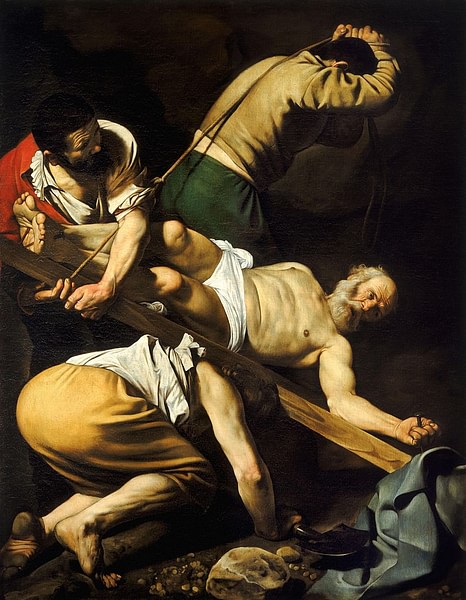
The site of Nero’s persecution was on Vatican Hill and became an early pilgrimage site. Constantine I (r. 306-337 CE) built the first basilica, St. Peter’s, followed by renovations over the centuries. In the 1940s CE, archaeologists discovered a 1st-century CE tomb beneath the catacombs in the Vatican, with some graffiti indicating that it was the tomb of Peter. The bones have been verified as a male of about 60 years old, dated to the 1st century CE. The Vatican’s identification of the bones as Peter remains under dispute.
The Primacy of Peter
In 90 CE, a bishop of Rome, Clement (d. 99 CE), claimed that Rome was the city of the martyrdom of both Peter and Paul:
Peter, through unrighteous envy, endured not one or two, but numerous labors; and when he had at length suffered martyrdom, departed to the place of glory due to him. Owing to envy, Paul also obtained the reward of patient endurance ... and suffered martyrdom under the prefects. (1 Clement 5)
Subsequent Christian histories all included references to Peter’s martyrdom in Rome. When the Catholic Church became institutionalized in the 4th and 5th centuries CE, retrospectively, Peter was understood to be the first bishop of Rome. Matthew’s commissioning of Peter was utilized as iconic for the validation of the authority of the Roman Church. Sculpted keys of the kingdom are found throughout Vatican City and the Pope simultaneously holds the title of bishop of Rome. The authority to forgive sins on earth is understood as being passed down from the first bishop, Peter. Above the main altar is a reliquary that allegedly holds the chair of Peter. The chair was a gift from the Emperor of the Romans, Charles the Bald in 875 CE. Peter remains one of the most popular apostles, as a lowly, humble character who nevertheless reached the pinnacle of true faith.

